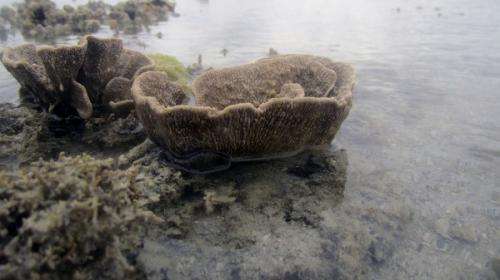Sea sponge study sheds light on coral reefs

A study of sea sponges on the Great Barrier Reef could help improve the management of WA coral reefs such as Ningaloo Reef.
The research examined the larval production and early stages of the fan-shaped sponge (Carteriospongia foliascens) to determine what influenced the young sponges' growth and survival.
WA Fisheries senior research scientist Dave Abdo, who was an author on the paper, says the study focussed on the period after the larvae left the adult sponge.
He says a myriad of different things can happen to a larva while it is drifting around in the water, such as being eaten by a fish.
"If it successfully lands on the sea floor it then has to still survive various different potential influences from grazing to being out-competed by algae, having sediment land on it...things like that," Dr Abdo says.
He says sponge growth can be difficult to measure because of the animal's shape so the research team used a relatively advanced technique known as stereo-photogrammetry.
"Essentially if you liken it to your vision it works along the same principles," Dr Abdo says.
"We have our two eyes, which allow us to perceive depth, and you have two camera lenses.
"When you take a stereo-photo and combine with specialised software...you can measure points across the two images and determine lengths and widths and heights."
Research breaks away from hard coral focus
Southern Cross University postdoctoral research fellow Steve Whalan says much of the research into coral reefs has been done on conspicuous hard corals, even though sponges can be the dominant structure in deep water where there is not enough light for corals.
"As a result of this concentration on hard corals we know very little about sponges," he says.
Dr Whalan says the study, which is set to be published in December in the Journal of Experimental Marine Biology and Ecology, is a really nice first step in identifying invertebrates other than corals on reefs and thinking about them in terms of coral reef management.
"In WA...you've got some amazing sponge gardens, they're just a little bit deeper in the coral reef areas in the North West, off Ningaloo and right up through the Kimberley," he says.
"So including sponges into monitoring programs that are associated with dredging etc. will become increasingly important."
Dr Whalan says recent studies in the Caribbean have revealed that sponges on coral reefs may be involved in nutrient cycles by targeting very small plankton as they filter water.
More information: Muhammad Azmi Abdul Wahab, Rocky de Nys, David Abdo, Nicole Webster, Steve Whalan, "The influence of habitat on post-settlement processes, larval production and recruitment in a common coral reef sponge," Journal of Experimental Marine Biology and Ecology, Volume 461, December 2014, Pages 162-172, ISSN 0022-0981, dx.doi.org/10.1016/j.jembe.2014.08.006.
Journal information: Journal of Experimental Marine Biology and Ecology
Provided by Science Network WA





















